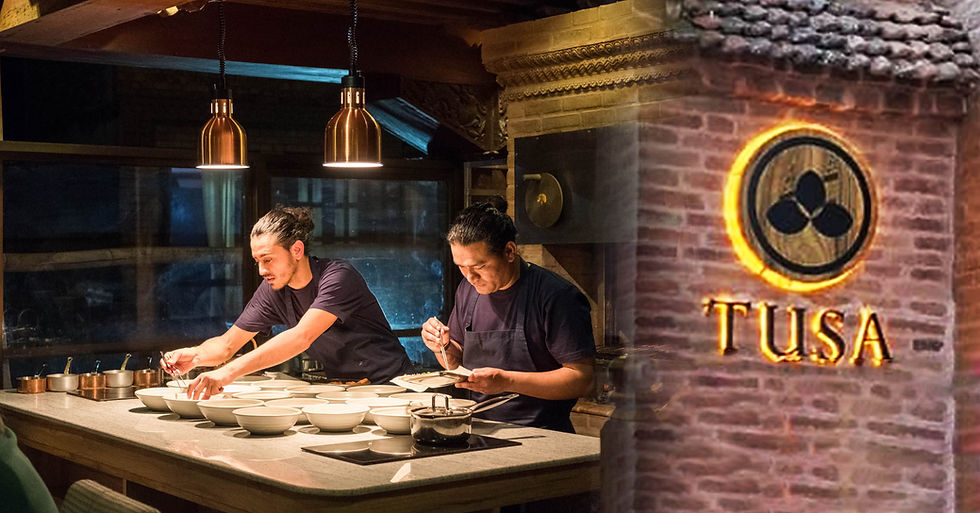Newar Gastronomy: A Living Intangible Cultural Heritage of Nepal
- The Chef Nepal
- Aug 23
- 4 min read
"In the heart of the Kathmandu Valley, food is more than nourishment — it is ritual, memory, and community. From the grandeur of Newar feasts to the humble momo, discover how Nepal’s living gastronomic heritage tells the story of a people and why it deserves a place on UNESCO’s global stage."

There are meals that fill the stomach, and then there are meals that tell the story of a people. In the Kathmandu Valley, where the Newars have lived for centuries, food is more than sustenance — it is ritual, memory, and a binding force of community. To sit at a Newar feast is to step into a theater of history, where every dish carries symbolism and every gesture encodes respect.
A Feast on the Lapte
The heart of this culture beats in the great feast known as Suku Bhwey, sometimes called Jho Bhwey or Lapte Bhwey. Guests settle cross-legged on straw mats, their meals served on plates sewn from fresh green leaves. The air fills with the clink of brass vessels, the perfume of spiced meat stews, the earthy sweetness of beaten rice. Before anyone eats, a divine portion — dyo chaye — is set aside for the gods. Only then do the hosts begin to serve, moving with ritual precision from elder to youth, repeating rounds of baji and meat, thwon and aila, until abundance itself seems to overflow. The feast always ends in blessing: yogurt for purity, fruit for renewal, sugarcane for sweetness ahead.
It is a choreography of generosity, but also of hierarchy and belonging. To leave before the feast concludes is unthinkable; to sit together until the last morsel is shared is to affirm the bonds of community.
Seasons on the Plate
The rhythm of the Newar table is the rhythm of the valley itself. Winter brings the gleam of takha and sanyakhuna — gelatinous meats set firm against the cold, rich with spice and marrow. Monsoon rains, meanwhile, call forth the greenness of the fields, light vegetable stews, cooling chutneys, the sour tang of lapsi. Each festival, each lunar turn, comes with its own menu, making the calendar itself a kind of cookbook, where season, spirit, and sustenance are written together.

And then there is the legendary Chaurasi Byanjan—the 84 ceremonial dishes once laid out at weddings, weaning rituals, and communal guthi feasts. To encounter such a spread is to sit before an edible cosmology: beans for fertility, yogurt for purity, beaten rice for prosperity. Abundance here is not gluttony—it is symbolism, an offering to the gods, to the ancestors, and to the living all at once.
The Knowledge in a Cup
No less important are the drinks. Rice beer, frothy and faintly sweet, ties the feast to the agrarian cycle. Aila, clear and fiery, is tested in flame before it is poured, a gesture as much spiritual as sensory. Then there are the drinks brewed for health and healing: simpu, the bean broth that warms; mee-kwa, the bitter-scented fenugreek drink; paun-kwa, sour-sweet with lapsi. These are more than refreshments—they are fragments of scientific memory, the wisdom of fermentation and distillation carried in families for generations.

Parallels and Belonging
Seen against the world’s great culinary traditions, the Newar feast stands comfortably in their company. France has its ritual meal, Japan its Washoku, Mexico its communal kitchens—and Nepal, in the Newar bhwey, offers a tradition just as intricate, just as profound. Like the French table, it is performance. Like Washoku, it honors season and nature. Like Mexico’s cuisine, it is held together by the labor and love of women, the keepers of recipes and rituals.
And then, of course, there is momo. Today the dumpling is Nepal’s national darling, eaten in tea shops and city cafés, in mountain villages and diaspora homes. But its roots lie in the Newar “momocha,” a festive food shared in communal kitchens. Its rise from ritual dish to global street food is itself a story of cultural survival—a reminder that living traditions adapt, spread, and endure.
Toward Recognition
To be invited to a Newar feast is to receive more than a meal. It is to enter a circle of memory, to eat from a plate of leaves stitched by hand, to sip beer that carries the breath of the fields, to taste sweets that bless the future. It is to experience a culture that has, for centuries, used food as language, as cosmology, as glue.

As UNESCO continues to recognize the world’s culinary heritages, Nepal has its own case to make. Registering Newar gastronomy—and alongside it, momo as a living symbol—would not only put Nepal on the global culinary map but would safeguard a tradition that continues to nourish body and spirit. More importantly, it would honor a people who have long known what the rest of the world is only beginning to see: that a meal is never just a meal. It is who we are, who we have been, and who we hope to remain.
Content credit: Chef Binod Baral












Comments